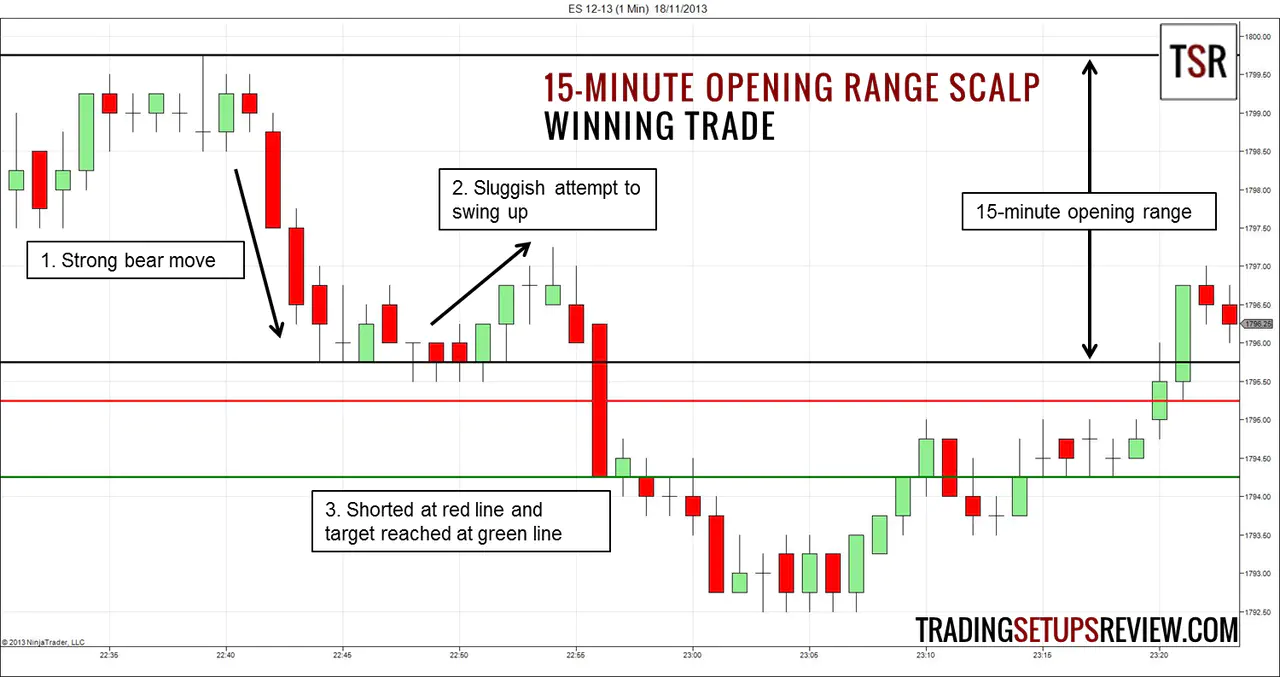The 15-Minute Opening Range Scalp Trading Strategy
By Galen Woods ‐ 4 min read
The 15-Minute Opening Range Scalp Trade is a time-sensitive trading strategy by Kevin Ho. It features a time stop to keep scalpers out of sideways market.
The 15-minute opening range scalp trade is among the ten scalping trade setups shared by Kevin Ho, a floor trader and a member of the Singapore Exchange, in his article in Chartpoint. It is a time-sensitive trade for the market opening of the S&P.
This opening range scalp trade is an excellent option for part-time day traders who can only watch the market for a limited time.
Opening Range Scalp Trading Rules
Rules for Long Trade
- Wait for the first 15-minute range to form
- Place buy order two ticks above the high of the range
- Exit with a 1-point loss or 1-point profit (or if the trade is still open after 1 minute)
Rules for Short Trade
- Wait for the first 15-minute range to form
- Place sell order two ticks below the low of the range
- Exit with a 1-point loss or 1-point profit (or if the trade is still open after 1 minute)
Trading Examples - Opening Range Scalp Trade
Winning Trade
Although this opening range scalp trade uses the 15-minute range, we used the 1-minute chart in our example to account for any whipsaw. In this case, the finer chart also gave us a sense of how quickly prices hit our target.
The black lines mark out the 15-minute opening range.
- Within the first 15 minutes, prices drifted up before a strong bear thrust took over.
- Almost immediately after the range formed, prices made a weak attempt to move up.
- The failure of the weak bull swing triggered our sell stop order placed two ticks away from the bottom of the opening range. In this case, setting the order two ticks below the range made all the difference. If we had placed the order one tick below the range, we would have shorted earlier and scratched the trade after a minute.
Losing Trade
Another opening of S&P E-mini futures shown using a 1-minute chart. While this opening range scalp trade was hardly profitable, the 1-minute time stop rule coupled with proper execution would have helped us to exit at break-even, incurring only the commission.
- Within the opening range, there are many small bars and dojis, which are signs of a trading session with contracted range.
- The buy order was triggered two ticks above the range but scratched after 1 minute. Not a bad outcome for a losing trade.
- Having a time stop was fortunate as the following congestion was terrible and might subject the anxious scalper to an emotional roller coaster.
Review - 15-Minute Opening Range Scalp Trade
This opening range scalp trade is straightforward and requires at most 16 minutes of your time.
As a scalping trade setup, its genius lies in having a fixed target and stop, coupled with a time stop.
In the losing example, we managed to minimize our loss by using the time stop. For scalping strategies, the risk to reward ratio is not fantastic. Hence, a time stop is essential.
To put the odds in your favor, you can also pay attention to the price action within the opening range to glimpse clues of the odds of a successful break-out.
Bear in mind that you might need to revise the suggested target and stop, and the two-tick buffer between the range extreme and our entry. Kevin Ho’s article gave examples from 2003. Scalpers should adjust them according to current market volatility.
Due to the time-sensitivity and high volatility of the market during its opening, you will need a decent trading platform to execute this trade setup accurately.
Minimally, you must use bracket orders when placing your trades. Ideally, your trading platform should set the time stop automatically as well.
To learn more about this opening range scalp trading strategy, you can find his article on many of the day trading forums out there. If you are interested in scalping trading strategies, you will want to take a look at jjrvat’s method.

